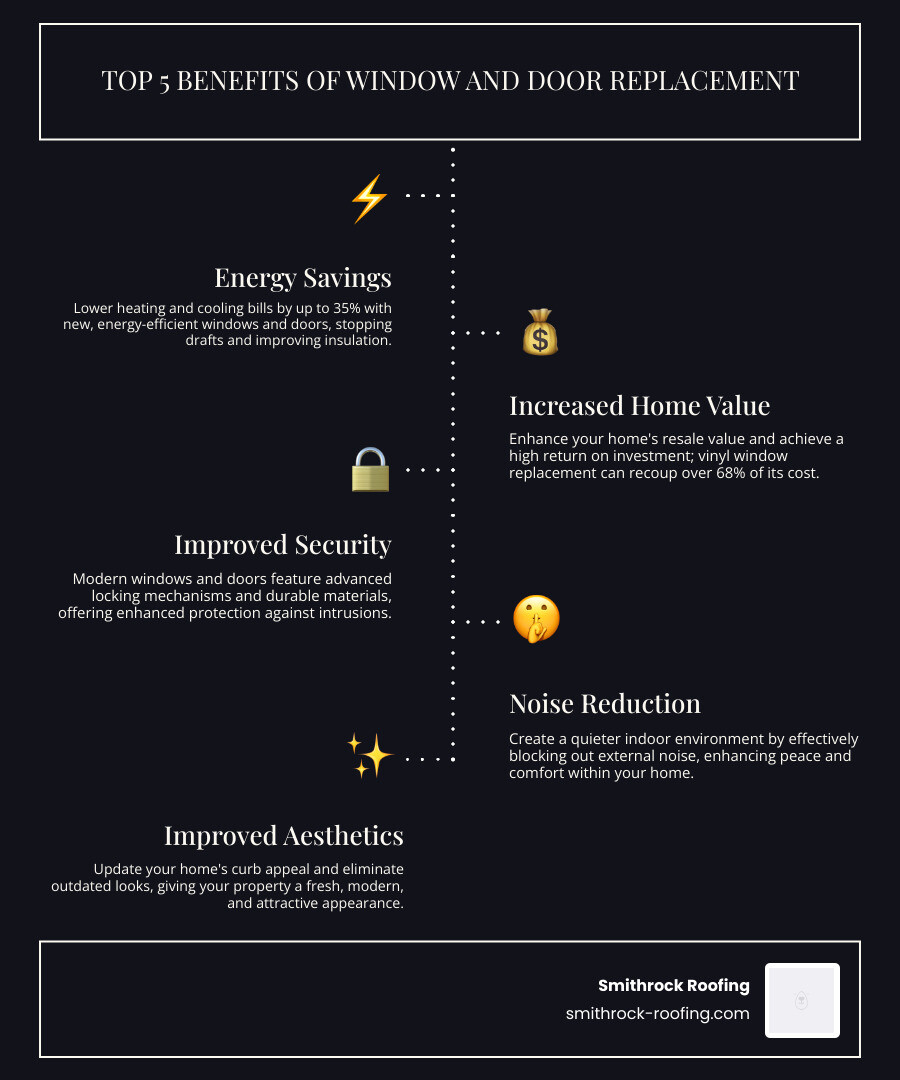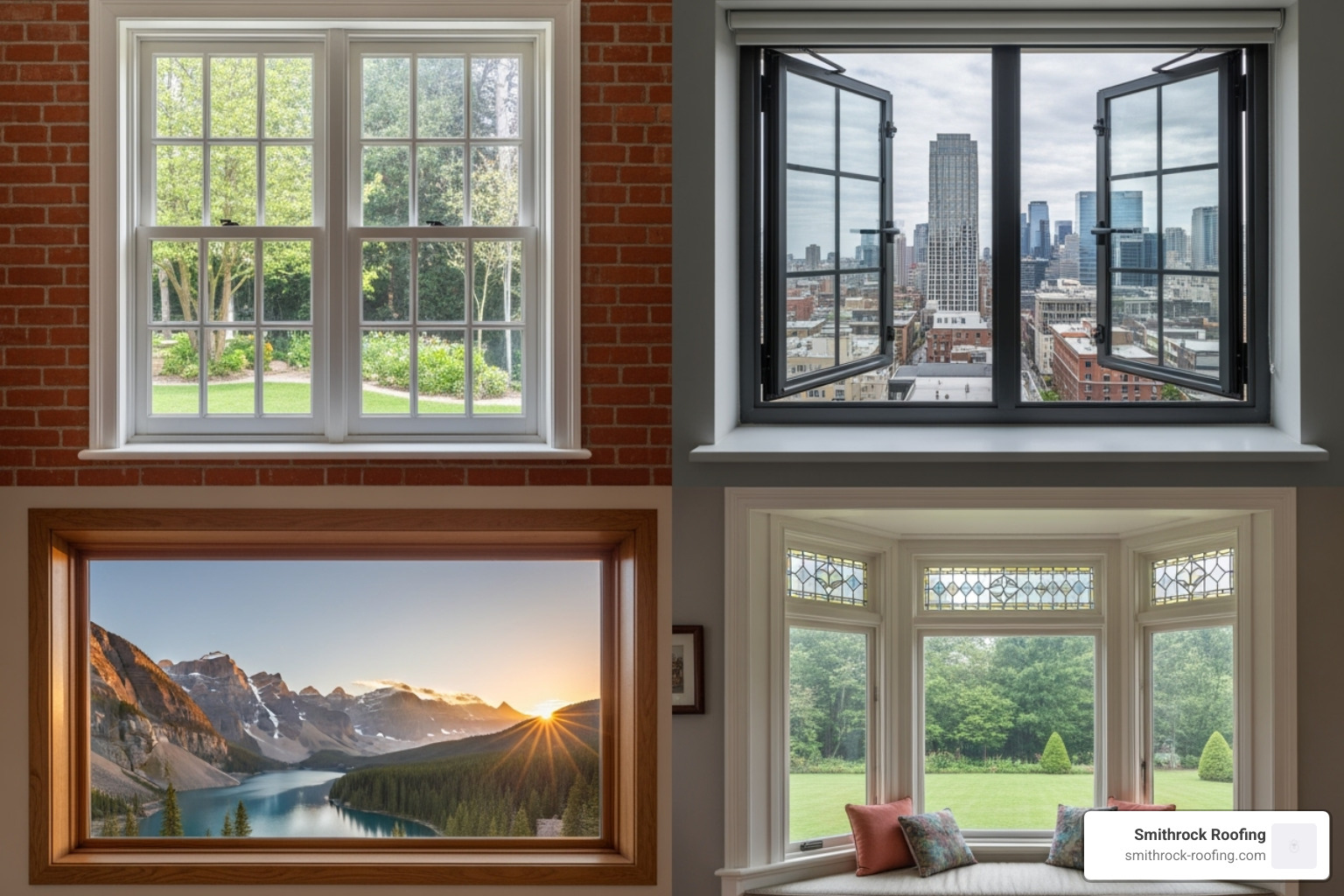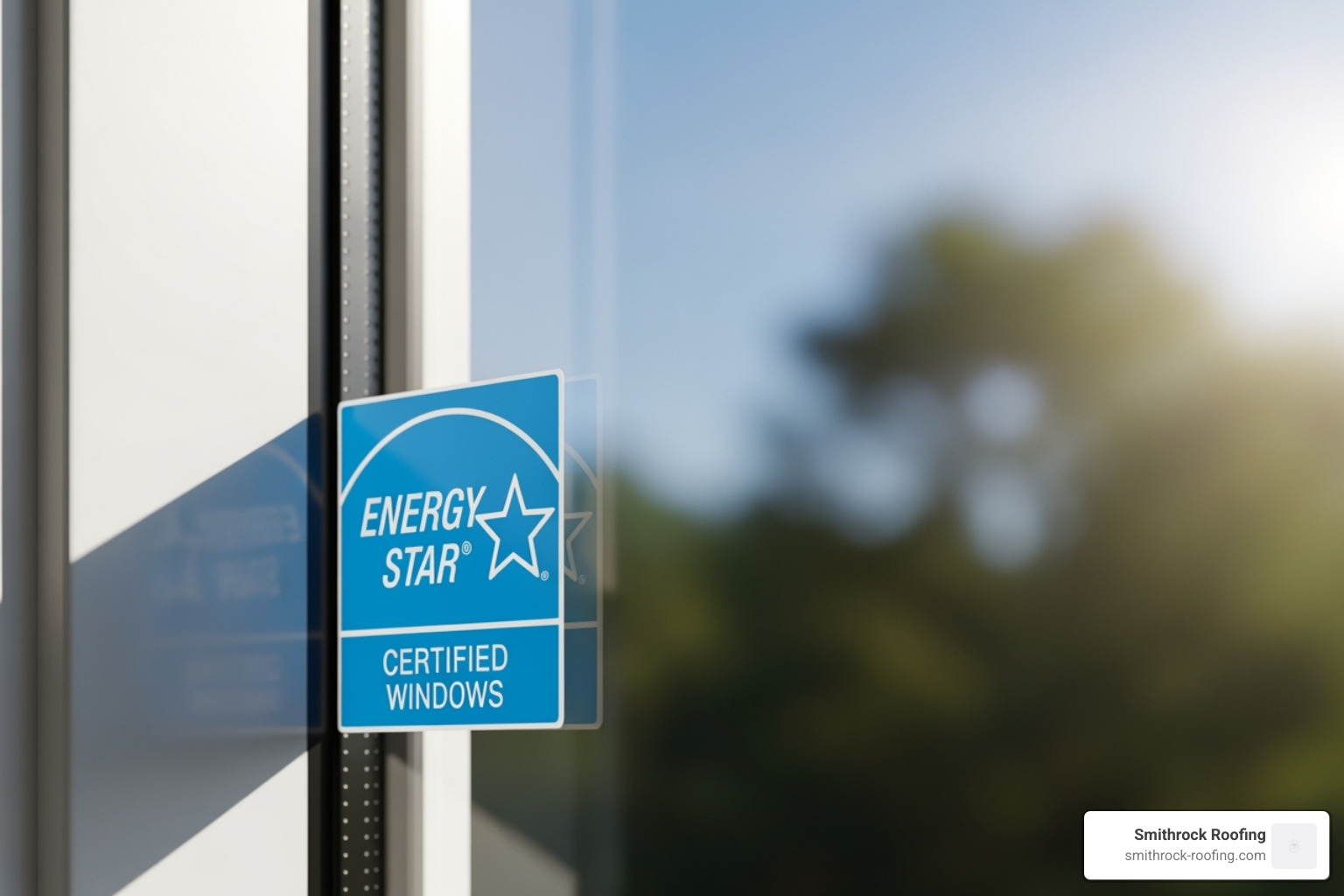Are you tired of chilly drafts that send a shiver down your spine, even with the heat on full blast? Do you cringe when you see your monthly energy bills, knowing your hard-earned money is literally flying out the window? Is your home simply not the sanctuary of comfort it should be? These are common frustrations that signal a deeper problem. For homeowners considering window and door replacement, here’s a quick overview of why it’s one of the smartest moves you can make:
Window and door replacement is one of the most impactful improvements you can make. It’s more than just a maintenance task; it’s a strategic investment in your property that pays off immediately by cutting utility costs, and continues to deliver value by boosting curb appeal, enhancing security, and increasing your home’s overall market value. As the experts say, “Replacing your windows and doors is something you should only have to do once.” This comprehensive guide will walk you through everything you need to know to make an informed decision with confidence.
As Jordan Smith, with over 15 years in exterior construction, I’ve seen how crucial a professional window and door replacement is for a home’s long-term health, comfort, and value. My experience is dedicated to helping homeowners steer their options and find the right solutions with honesty and integrity.

Similar topics to window and door replacement:
Your home has ways of signaling when it needs attention. When it comes to windows and doors, these signals can be subtle at first but become impossible to ignore over time. Recognizing them early can save you from bigger, more expensive problems down the road, turning a proactive upgrade into a smart financial decision.

Rising Energy Costs: This is often the first and most painful sign. If your heating and cooling bills are steadily climbing without a change in your usage habits, your windows and doors are the likely culprits. Old, single-pane, or poorly sealed units are thermal holes in your home’s envelope. Energy is lost in four key ways: conduction (heat passing directly through the glass), convection (air currents circulating between panes or around the frame), radiation (heat radiating through the glass), and air leakage (drafts). Inefficient units can let up to 35% of your home’s expensive conditioned air escape, forcing your HVAC system to work overtime just to maintain a baseline level of comfort.
Noticeable Drafts: Feeling a distinct draft near a closed window or seeing curtains gently move on a still day is a clear sign of air leakage from failed seals or warped frames. These drafts create uncomfortable hot and cold spots, making it difficult to maintain a consistent indoor temperature and leading to rooms that are always “too hot” or “too cold.”
Difficulty Opening, Closing, or Locking: Windows that stick, refuse to stay open, or doors that don’t latch securely are not just daily annoyances; they are significant safety hazards. A window that won’t open could be a blocked fire escape route, and a door that won’t lock properly leaves your home vulnerable to intruders. These issues often arise from aging frames that have warped, settled, or from worn-out hardware that can no longer function as designed.
Condensation Between Glass Panes: If you see fog, moisture, or mineral deposits trapped between the panes of a double- or triple-pane window, it’s a definitive sign of a failed seal. The insulating argon or krypton gas has escaped and been replaced by moisture-laden air. This means the window’s energy efficiency is significantly compromised, and it’s no longer providing the insulation you paid for. This foggy appearance cannot be cleaned away and will only worsen over time.
Water Damage, Peeling Paint, or Rot on Frames: Carefully inspect the frames and sills around your windows and doors. Look for soft spots in wood, peeling or bubbling paint, and dark discoloration. These are telltale signs of water intrusion. Even a small, slow leak can lead to pervasive wood rot, mold growth that can affect your family’s health, and eventually, structural damage to your walls.
Fading from UV Damage: Have you noticed your furniture, hardwood floors, carpets, or artwork fading in sunny spots? This indicates your current windows lack adequate UV protection. Modern windows come with advanced Low-E coatings that are specifically designed to filter out up to 99% of harmful ultraviolet (UV) rays, preserving your home’s valuable interiors while still letting in beautiful natural light.
Excessive Outside Noise: If you can clearly hear every passing car, neighborhood conversation, or barking dog from inside your home, your windows and doors are not providing proper sound insulation. A modern window and door replacement with multiple panes, insulating gas, and advanced sealing systems can create a dramatic reduction in outside noise, turning your home into a much quieter and more peaceful retreat.
Outdated or Unattractive Appearance: Sometimes, the issue is purely aesthetic, but no less important. Old, weathered, or mismatched windows and doors can make a home look dated and neglected. A fresh, modern replacement can dramatically improve your home’s curb appeal, express your personal style, and boost your pride in its appearance.
If you’re experiencing any of these signs, it’s time to seriously consider an upgrade. These problems rarely get better on their own and tend to worsen over time, so addressing them promptly is the smartest and most cost-effective move.
Ready to learn more? Check out more info about our window services to see how we can solve these common problems.
Once you’ve decided to upgrade, the exciting part begins: exploring the wide array of available window and door styles. This is your chance to blend high-performance functionality with your personal aesthetics, choosing options that not only perform well but also perfectly complement your home’s unique architecture and character.
Windows define your home’s personality and have a major impact on your living spaces. Here are the most popular options:

Double-Hung Windows: A timeless American classic, this is the most common style in the country. It features two vertically sliding sashes, offering excellent ventilation control. You can open the bottom sash to let in a cool breeze, the top sash to vent warm air near the ceiling, or both for maximum air circulation. Most modern versions feature tilt-in sashes, which is a game-changer for cleaning. Best for: Traditional home styles like Colonial, Cape Cod, and Victorian; rooms on any floor where easy cleaning and versatile ventilation are priorities.
Single-Hung Windows: Similar in appearance to double-hung, but only the bottom sash moves up and down while the top sash is fixed. This simpler design makes them a more economical choice that still offers a classic, traditional look. Best for: New construction projects or situations where budget is a primary concern and top-sash ventilation is not needed.
Casement Windows: Hinged on one side, these windows operate with a hand crank and swing outward like a door. This design creates an exceptionally tight seal when closed, making them one of the most energy-efficient operable window styles. They provide an unobstructed view and can be angled to catch and direct breezes into the home. Best for: Hard-to-reach areas like over a kitchen sink or countertop, and in contemporary or modern homes.
Sliding Windows: Also known as gliders, these windows slide horizontally on a track. They are simple to operate, require no exterior or interior space to open, and offer a clean, contemporary look with a wide, unobstructed view. Best for: Modern and ranch-style homes, rooms facing walkways or patios, and openings where the width is greater than the height.
Picture Windows: These are large, fixed, inoperable windows designed for one purpose: to maximize natural light and frame a beautiful view like a piece of art. Because they don’t open, they offer superior energy efficiency and are often paired with operable windows like casements to provide ventilation. Best for: Living rooms, dining rooms, or any space with a scenic view that deserves to be the focal point.
Bay and Bow Windows: These stunning window combinations project outward from the home’s exterior wall, creating extra interior space and a flood of natural light. Bay windows typically consist of three windows (a central picture window flanked by two angled windows), while bow windows feature a more gentle curve of four or more windows. Best for: Creating a dramatic focal point, a cozy reading nook, or a breakfast corner in a kitchen or living room.
Awning Windows: Hinged at the top, these windows open outward from the bottom with a crank. This unique design allows for ventilation even during a light rain, as the sash acts as a protective awning. They are often placed higher on walls for privacy or stacked with other window types. Best for: Bathrooms, basements, and kitchens where privacy and weather-protected ventilation are key.
For more information, check out More info about adding windows.
Doors provide security, insulation, and a critical first impression. They come in various styles and materials to suit any need.
Entry Doors: As the focal point of your home’s exterior, the front door must be durable, secure, and stylish. Common materials include fiberglass (durable, low-maintenance, versatile), steel (secure, affordable), and wood (classic beauty, natural insulator), each offering different benefits in insulation, maintenance, and appearance.
Patio Doors: These doors are designed to connect indoor and outdoor living spaces seamlessly.
When selecting any door, it’s crucial to consider security features like multi-point locking systems and reinforced materials, as well as material options that are best suited for your local climate and personal maintenance preferences.
Choosing the right materials for your window and door replacement is one of the most critical steps in the entire process. Your choice will directly impact long-term durability, required maintenance, upfront cost, energy efficiency, and your home’s overall aesthetic. Understanding the unique strengths and weaknesses of each material will empower you to make a smart, informed decision that fits your budget, climate, and lifestyle.
The frame is the structural backbone of your windows and doors. It provides strength, stability, and plays a huge role in insulation. Here’s a look at the most popular options:
| Material | Cost | Maintenance | Durability | Insulation | Aesthetics |
|---|---|---|---|---|---|
| Vinyl | Low-Medium | Very Low | Good | Good | Modern, limited color options |
| Wood | High | High | Good | Excellent | Classic, natural, highly customizable |
| Fiberglass | Medium-High | Very Low | Excellent | Excellent | Modern, sleek, can mimic wood |
| Composite | Medium-High | Low | Excellent | Excellent | Wide range, can mimic wood, very stable |
| Aluminum | Medium | Low | Very Good | Poor | Slim, modern, best for temperate climates |
Vinyl Windows: Vinyl is the most popular window material in the United States, offering an unbeatable combination of affordability, energy efficiency, and low maintenance. Made from polyvinyl chloride (PVC), vinyl frames have multi-chambered construction that creates insulating air pockets, helping to reduce heat transfer. They are exceptionally durable, moisture-resistant, and will never need to be painted, scraped, or stained. High-performance vinyl options, like the Norandex eXtreme 3000S windows we offer, are engineered with advanced polymers to handle extreme temperature fluctuations without warping, cracking, or peeling.
Wood Windows: For timeless beauty and natural charm, nothing compares to wood. It’s a natural insulator and can be painted or stained to perfectly match any architectural style. However, this beauty comes at a cost of higher maintenance. Wood requires regular sealing, painting, or staining to protect it from moisture and rot. Many modern wood windows feature exterior cladding (a protective shell of vinyl or aluminum) to reduce upkeep while preserving the warm, natural wood look on the interior.
Fiberglass Windows: Incredibly strong, durable, and energy-efficient, fiberglass is a superior choice for any climate. It’s made from strands of glass, so it expands and contracts at nearly the same rate as the glass panes it holds. This reduces stress on seals, preventing leaks and ensuring a longer lifespan. It’s roughly 8 times stronger than vinyl, resists warping and fading even in extreme heat, and requires very little maintenance. It can also be painted to match your home’s evolving style.
Composite Windows: These windows blend different materials, such as wood fibers and durable plastics, to create a product with the best qualities of each. They offer the strength and stability of wood with the low-maintenance and weather-resistant properties of vinyl. Composites like Andersen’s Fibrex® are twice as strong as vinyl, resist rot and decay, and provide exceptional insulation.
Aluminum Windows: Known for their strength and slim frames, aluminum windows are a popular choice for modern and commercial designs where maximizing glass area is a priority. They are lightweight, durable, and low-maintenance. However, aluminum is a highly conductive material, making it the least energy-efficient option. It’s best suited for temperate climates or as interior partition windows where thermal performance is not a concern.
For a deeper dive into materials, you can check out what the experts at Consumer Reports have to say.
The glass package you choose is just as important as the frame. Modern glass technology is what truly drives energy efficiency, comfort, and security.
Glazing: This refers to the number of glass panes. Double-pane glass is the modern standard, featuring two panes separated by a sealed air gap for insulation. Triple-pane glass adds a third layer and a second air gap for superior insulation and noise reduction, making it ideal for extreme climates or homes near busy roads.
Gas Fills: The space between the panes is often filled with dense, inert, and harmless gases like Argon or Krypton. These gases are far better insulators than regular air, dramatically slowing heat transfer and boosting the window’s overall energy efficiency.
Low-E Coatings: Low-emissivity (Low-E) coatings are one of the most important advancements in window technology. These are microscopically thin, transparent metallic layers applied to the glass surface. They work year-round by reflecting indoor heat back inside during the winter and blocking the sun’s infrared heat from entering in the summer, all without reducing visible light.
Tempered Glass: This is a type of safety glass that is heat-treated to be four to five times stronger than standard glass. If it does break, it shatters into small, blunt, pebble-like pieces rather than sharp shards, significantly reducing the risk of injury. Building codes often require tempered glass in doors, next to doors, and in bathrooms.
Laminated Glass: For the ultimate in security and soundproofing, laminated glass is the top choice. It’s made by bonding a tough, transparent plastic interlayer (PVB) between two panes of glass. When struck, the glass may crack, but it stays held together by the interlayer. This provides a significant security boost against intruders and offers excellent sound insulation, effectively dampening outside noise.
It’s essential to view a window and door replacement project as a long-term investment in your home’s future, not just an upfront expense. The initial cost is consistently offset by tangible long-term benefits like significant energy savings, a measurable increase in home value, and a dramatic improvement in daily comfort, providing an excellent return on investment (ROI).

The final price tag for your project can vary widely. Understanding the key variables will help you set a realistic budget:
To see how these costs add up, you can review the See the latest Cost vs. Value Report.
While costs vary by region and project specifics, a single vinyl replacement window can range from $250 for a basic builder-grade insert to over $3,000 for a high-end, custom, full-frame replacement window, before installation. For example, a sliding window might cost $320 to $1,300, while a bay window could be $400 to $5,500 for the unit alone.
Installation costs add to these figures. A mid-range vinyl window replacement project (e.g., ten windows) might average around $20,091. However, national studies show this project can recoup about $13,766 in home value at resale—a 68.5% return on investment.
A sliding patio door replacement typically costs between $800 and $2,000 for the unit, plus installation.
We understand this is a significant investment. That’s why we offer various financing options with competitive rates and flexible payment plans to fit your budget. These options can make your project immediately affordable, allowing you to enjoy the benefits of new windows and doors now while paying over time. When you schedule a consultation, ask about any special offers available. Exploring resources like Learn about financing options can also help you plan your project.
Beyond the initial cost, a professional window and door replacement delivers substantial, long-term value that transforms your home. It’s an upgrade that not only improves daily life by making your space more comfortable and beautiful but also adds tangible, measurable value to your property.
This is a primary motivator for many homeowners, and the savings are real. Old, drafty windows and doors are major sources of energy loss. New, energy-efficient units with advanced frames and glass packages minimize this loss, leading to significant and immediate savings on your monthly utility bills.

Key energy efficiency ratings to look for:
Upgrading from single-pane to ENERGY STAR certified windows can save the average homeowner 12-13% on their annual energy bills. This translates to a more consistent indoor temperature, fewer drafts, and a smaller carbon footprint. There are even benefits to Why Fall and Winter Are the Perfect Time for Window Replacements.
New windows and doors offer a host of other compelling benefits that improve your home and lifestyle:
A professional window and door replacement project can be a smooth, stress-free, and highly rewarding experience when you partner with the right team. A successful outcome hinges on meticulous planning, expert craftsmanship, and clear communication at every stage of the process.
Selecting the right contractor is the single most critical decision you’ll make for your project’s success. A great window can fail if installed improperly. Here’s what to look for in a trustworthy partner:
Once you’ve chosen a trusted partner like Smithrock Roofing, the process is designed to be clear and straightforward:
It’s natural to have questions about a major home improvement project like a window and door replacement. Getting clear answers helps you move forward with confidence. Here are some of the most common questions we hear from homeowners.
While many homeowners assume spring or summer are the only ideal times, a professional window and door replacement can be done efficiently and safely year-round. Experienced installers use proven techniques to minimize your home’s exposure to the elements, regardless of the season. In fact, there are distinct advantages to off-season installation in the fall and winter. You may find that contractors have more flexible scheduling and availability, leading to a quicker project start time. You might also find special offers or better pricing during these traditionally slower months. Installing new, energy-efficient windows in cooler weather provides an immediate, noticeable improvement in your home’s comfort and can start lowering your heating bills right away. Our teams work on one opening at a time, removing the old unit and immediately installing the new one to ensure minimal energy loss and disruption.
Learn more about the best time to replace windows
Yes, absolutely. While replacing all your windows at once provides the greatest aesthetic consistency and maximizes your home’s overall energy efficiency, it’s entirely possible and very common to replace them in phases. This approach is excellent for budgeting, allowing you to spread the cost over time. It also lets you prioritize the most problematic windows first—tackling those with significant drafts, operational issues, or damage. The main consideration is that the per-window cost is often lower when replacing multiple units in a single project due to efficiencies in labor and setup. However, addressing your worst windows now is always better than waiting.
The project timeline depends entirely on the size and complexity of the job. A single, standard window replacement can often be completed in just a few hours. A whole-house project involving ten to fifteen windows and a patio door will naturally take longer, typically spanning two to four days. Factors that influence the timeline include the number of units, the type of installation (a full-frame replacement takes longer than a pocket insert), the condition of the existing openings (any hidden rot or damage will require repairs, adding time), and the complexity of the units (custom shapes or large bay windows require more time). During your initial consultation, we will provide a clear, realistic timeline based on the specifics of your project.
These two types of windows are designed for different applications. New construction windows have a nailing fin (or flange) around the perimeter, which is used to nail the window directly to the home’s sheathing. They are used when the wall studs are exposed, as in a new home build or a major remodel. Replacement windows (like pocket inserts) are designed to fit into an existing window frame and do not have a nailing fin, allowing for installation without disturbing the home’s exterior siding or interior trim.
You should expect two separate warranties. First is the manufacturer’s warranty, which covers the product itself. This often includes a lifetime warranty on the frame against defects and a 20- to 25-year warranty on the insulated glass unit against seal failure. The second, and equally important, is the installer’s workmanship warranty. This covers any issues arising from the installation itself. A reputable contractor will offer a strong workmanship warranty of at least several years, protecting your investment against leaks or operational problems caused by improper installation.
Undertaking a window and door replacement project is a significant and powerful investment in your home’s comfort, value, security, and future. The result is more than just new hardware; it’s a home transformed—free from chilly drafts and high energy bills, with a fresh, updated look that boosts curb appeal and tangibly improves your daily life.
Success, however, depends on two equally important factors: selecting high-quality, energy-efficient products custom to your climate, and partnering with a professional, trustworthy installer. Expert installation is crucial to open uping the full performance and longevity of your new windows and doors. A perfect window installed improperly will fail, leading to the very drafts, leaks, and energy loss you sought to eliminate and voiding manufacturer warranties. Your investment deserves the protection of superior craftsmanship.
At Smithrock Roofing, we are that trusted partner. We are committed to providing a seamless customer experience and flawless installation on every project. We offer a full suite of home improvement solutions, including roofing, gutters, siding, and exceptional window and door replacement services. We are proud to serve our neighbors and homeowners across Winston-Salem, King, Clemmons, Lewisville, Pilot Mountain, East Bend, Mt. Airy, Kernersville, Siloam, Danbury, High Point, Trinity, Pfafftown, Tobaccoville, Greensboro, Walnut Cove, Belews Creek, Rural Hall, Pinnacle, Bethania, Advance, Wallburg, Horneytown, Union Cross, and Midway, NC. Our local expertise ensures your project is handled with the highest standards of quality and care, from start to finish.
Ready to experience the profound difference new windows and doors can make? Let us guide you through this exciting change with the confidence that comes from working with the best.
Contact us for your roofing and window needs and let’s begin your journey to a more comfortable, beautiful, and energy-efficient home.

Smithrock Roofing © Copyright 2025 • All Rights Reserved • Maintained by Mongoose Digital Marketing